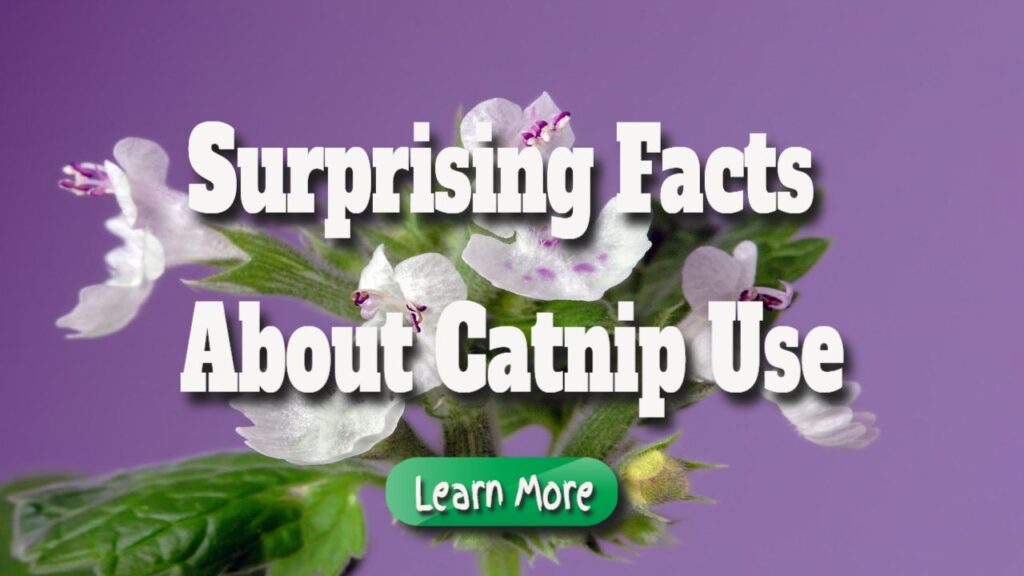Surprising Facts About Catnip Use
What exactly is Catnip?
Surprising Facts About Catnip Use: Catnip is a member of the mint family of herbs. It’s more than just a plant that makes cats happy. Catnip has long been used as a tea to aid digestion and relaxation, and it also works well as a mosquito repellent.
What happens when it comes to cats? To understand this, you must first be acquainted with cats. The vomeronasal organ, also known as Jacobson’s organ, is a second organ located on the roof of a cat’s mouth.
That’s why cats have such a good sense of smell; they pick up scents (sometimes with their mouths open and lips apart, giving the appearance of having come across something foul-smelling), and the information is transmitted directly to their brains, where it is interpreted.
1. Catnip is a herb that is related to the mint family. Nepeta cataria is its scientific name.
2. Catnip is often referred to as cat herb or Catnip.
3. It originated in Europe and was imported to the United States and other countries (where it now flourishes like a weed!).
4. Nepetalactone, a substance found in Catnip, is responsible for your cat’s familiar “high.”
5. Catnips high only lasts around 10 minutes. After then, your cat will become accustomed to it, and you will have to wait around two hours for her to be receptive to the effects of Catnip once more!
6 Although it is frequently compared to LSD or marijuana, Catnip is generally not toxic to cats and cannot be overdosed on.
Catnip is well-known to everyone who has a cat. It comes in sprays, plants, dried, and toy forms! Here are some intriguing facts about Catnip that you may not know.
Do you want to try something fresh and exciting for your next project?
Perhaps you want to wow your friends and family with something unique.
Perhaps you want to surprise your clients with something they haven’t considered! Have you ever thought about integrating catnip into one of your products?
Catnip, for sure! What will drive your adorable little cats mad!
Catnip has several uses, including medication, food and beverages, bath and body products, skincare, soap making, and even hair care!
Catnip has so many wonderful uses, especially in bath and body products! Catnip can be found in a variety of bath and body products, including face masks, scrubs, lotions, soaps, ointments, creams, shampoos and conditioners, and bath teas.
Catnip, when used in soap, aids in the healing of several skin disorders such as acne and contributes to relaxation.
Catnip can also help with hair maintenance. It conditions, smoothes, and hydrates hair.
Catnip can also be used to treat dandruff caused by an infected scalp. Catnip acts as a natural astringent, tightening lax skin and muscles.
In nature, it is also an antiseptic and disinfectant. It even slows the aging process, heals acne, and speeds up wound healing and regeneration.
Catnip also has numerous therapeutic properties.
Catnip can help relieve period cramps, pains, and spasms in women, and it can also help females with delayed cycles start their menstrual cycles.
It can be used to treat colds, flu, swine flu, rheumatism, arthritis, indigestion, worms, insomnia, flatulence, diarrhea, colic, anxiety, fever, hives, measles, upset stomach, and hyperactivity.
Catnip can also be used to treat hemorrhoids and as a compress to relieve body edema.
It can also help cure inflammation and edema caused by airborne allergies, colds and flu, and even excessive alcohol consumption.
Catnip has antibacterial, antimicrobial, disinfecting, antispasmodic, antifungal, anesthetic, and sedative properties.
It can even aid with a variety of nervous system issues such as Alzheimer’s, vertigo, and Parkinson’s disease.
Did you know Catnip may be used to ward off insects, mice, rats, and bugs? Or that it has been used to flavor love potions?
Cats respond to this perfume in a variety of ways: they may become more vivacious and active, friendlier, or relaxed and happy.
Inhaling Catnip produces a hyperactive state, however, ingesting it produces a more calm state.
Cats may also experience pain relief and anxiety decrease. In rare cases, catnip may make certain cats more aggressive.
Catnip can be a fun activity for cats as well as a therapeutic technique for anxiety reduction, such as separation anxiety.
It’s also worth noting that, contrary to popular belief, Catnip does not work on all cats! While statistics vary, it is plausible to assume that more than half of all cats (about 60%) respond to Catnip.
This appears to be due to genetic factors; some cats lack the genetic traits that generate catnip reactions.
A fascinating truth is that cats in Australia have a stronger resistance to this green shrub (i.e., no reaction).
It attracts cats while repelling bugs!
Nepetalactone, the central element in Catnip, is an effective insect repellant! You can keep itching bugs away by growing some of this plant in your garden, but it may attract the neighborhood kitties!
Is Catnip harmful?
The quick answer is that it can be dangerous if you don’t know how to obtain Catnip. To be safe, only buy imported Catnip if you are completely aware of the risks.
Catnip isn’t harmful in and of itself, however, some cats love it and others just roll around in it. Catnip can help with digestion.
As with other things, though, too much of a good thing may be dangerous. Catnip in excess might cause digestive problems in your cat.
If your cat likes Catnip, he may try to open the package that contains it. If your cat consumes too much Catnip at once, it may experience indigestion and vomiting.
Their behavior is similar to that of an overdose, and while terrifying, it is not life-threatening. This is also why concentrated catnip oils should be avoided.
Because the active ingredient in catnip is an oil found in the leaves, it degrades over time. The oils in ancient Catnip volatilize and dry up, rendering the herb ineffective. It, like any other tea, spice, or herb in your kitchen, loses its potency as it ages.
By the way, you don’t have to worry about addiction. Catnip is not more addictive than any other recreational item, nor does it create withdrawal symptoms. It is only a passing pleasure for your feline companion.
You can use Catnip to either stimulate or rest your cat, depending on how he reacts.
The effects of catnip last about 10 to 15 minutes after you give it to your cat. She may not reap the benefits of the plant for another hour or two.
Catnip has the ability to make your cat sleepy or energetic!
Catnip provides a stimulating and euphoric effect when inhaled by your cat. When she consumes a few pieces, though, it usually has a relaxing and sedative effect! While the effect lasts just around 10 minutes, the kitten takes 1 to 2 hours to react again.
Catnip is not harmful to all cats!
The nepetalactone reaction is an inherited trait that affects around 70% of cats! Catnip can influence even enormous cats like tigers and lions! It is risk-free and does not lead to addiction!
While Catnip can cause strange behavior, it is not harmful to your cat. Just make sure it’s organic to avoid the irritating pesticides.
Consuming Catnip, according to American legend, will turn the sweetest person into the meanest person!
The post Surprising Facts About Catnip Use appeared first on https://gqcentral.co.uk




